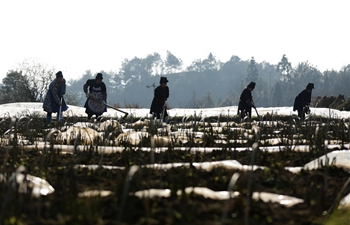BEIJING, Feb. 22 (Xinhua) -- Zhou Weiqi, who's in charge of a cooperative in central China's Henan Province, used to hope for a bountiful harvest on his farm. But this year, he cares more about the crop quality.
Located in Xunxian County in Henan, one of the leading grain producing areas in China, Zhou's cooperative grows over 3,000 mu (200 hectares) of wheat. To increase wheat quality, the cooperative has worked with the Institute of Science and Technology of Henan, planting a new wheat variety on the farm.
"As a major grain producing county in Henan, agricultural structure adjustment has been carried out over the past few years. Xunxian has been making efforts to realize a transition from a phase of rapid growth to a combination of quantity and quality," said Hu Zhenfang, an agronomist with the agricultural bureau of Xunxian County.
Hu said Xunxian is the epitome of the country's high-yield-to-high-quality transition. "We are now focusing on both output and quality, as well as going green and food safety. It is actually an upgrade of the agricultural structure."
China pledges to optimize its agricultural structure, according to the "No. 1 central document," released by central authorities Tuesday.
In the process of agricultural structure adjustment, the country moves to further improve grain quality, increase soybean planting, support the dairy industry as well as strengthen food safety, the document said.
It also noted that China will strive to ensure an effective supply of major agricultural products. Grain planting area, arable land area, as well as high-standard farmland by 2020 were made public.
"The document has clearly signaled that food production is one of China's top priorities," Minister of Agriculture and Rural Affairs Han Changfu said.
HIGH QUALITY BRINGS BENEFITS
In Henan, the provincial agriculture department said pilot projects of high-quality wheat promotion had been conducted in eight counties, with the area of high-quality wheat farmland increasing to 8.4 million mu (560,000 hectares) in 2018.
High-quality produce is now in high demand because of the rising middle-class consumers.
Although the price of high-quality wheat is five to six times more than the ordinary one, wheat produced in the eight counties has already sold out.
Growing high-quality wheat is also a way to increase farmers' incomes.
"There's a good market in high-quality products, and I've never been worried about finding buyers. I earn 300,000 yuan (44,600 U.S. dollars) to 400,000 yuan more every year since I started planting high-quality wheat," said Xia Sande, a large local producer.
INDUSTRY VITALIZATION
The "No.1 central document" also stressed the development of a farm produce processing industry, encouraging the formation of processing industry clusters in main grain producing areas.
Zhengyang County in Henan, a major peanut supplier, has been seeking ways to improve the peanut industry. Peanuts are major oil crops in China.
Instead of simply planting peanuts, the county has developed an industrial chain including peanut oil production, roasted peanuts, peanut protein, peanut milk and peanut shell refractory slabs, said Li Helin, president of a local cooperative.
The county now has 23 peanut processing enterprises, providing more than 30,000 job opportunities. It has also established cooperation with well-known large businesses due to its reputation of the well-developed peanut industry.
In north China's Inner Mongolia Autonomous Region, an important milk producing area, efforts including fostering standardized and scale farming, have been made to revitalize the dairy industry.
To achieve the goal, the region will build up more high-standard pastures by 2020, said Liu Yueping, director of the agriculture and animal husbandry bureau in the city of Hohhot, the region's capital.
Liu said high-level pasture management institutes are also expected to be introduced in the city so that milk quality and management can catch up with the advanced international level.

















